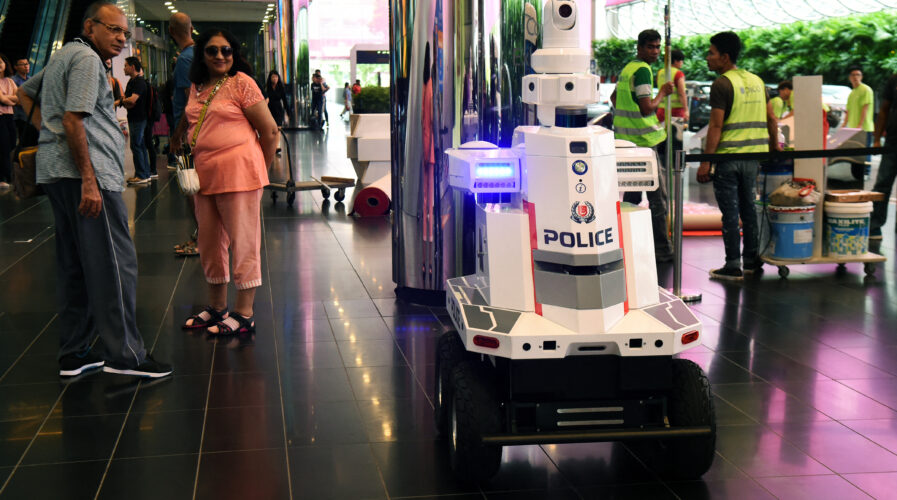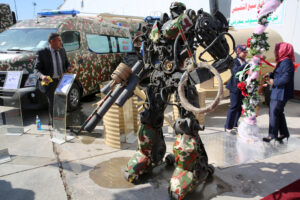
A ‘police robot’ patrols at the Suntec City convention and exhibition centre during the 33rd Association of Southeast Asian Nations (ASEAN) summit in Singapore on November 12, 2018. (Photo by Roslan RAHMAN / AFP)
Are autonomous robots the future of security?
Remember Robocop? He was the coolest cyborg cop enforcing the law without any fear or favor. While it may be a very long time before we see a real Robocop, the idea of having autonomous robots providing security has been rather promising.
Advancements in technology, especially in artificial intelligence (AI) have enabled the creation of robots that can now protect and serve the community. While these robots do not have the brain and body of a real cop, they can pretty much provide some decent protection.

An armed robot is displayed at a security and defence equipment fair in Baghdad on March 9, 2019. (Photo by SABAH ARAR / AFP)
And what better place to test these autonomous security robots (ASR) than Las Vegas. According to reports, Knightscope, a Silicon Valley company has introduced an autonomous security robot to protect an apartment complex in Vegas.
The autonomous robot nicknamed Westy is a K5 model that stands just over five feet tall. Powered by AI, Westy roams the neighborhood complex at human speed. Fitted with four internal cameras that provide a constant 360-degree view, it is also able to scan and record license plates. The AI enables unique digital identifiers as well.
K5 has also been providing its services to the Grand Sierra Resort and Casino in Reno. Autonomous robots like Jackbot monitors surroundings as well with their cameras and an added thermal camera. The K5 seeks out anomalies that suggest criminal activity such as people in restricted areas. It then alerts the casino’s security personnel on duty.
While the results of the ASRs are still tangible, the market demand for such products is expected to grow. It is estimated that the global security robot market is expected to reach US$ 4 billion by the end of 2027. With improved robotic technologies, better IoT sensors, and network connectivity, ASRs may very well disrupt the security industry in the near future.

A Hong Kong Police Explosive Ordnance Disposal Bureau (EOD) officer controls a bomb disposal robot during an inter-departmental counter-terrorism exercise codenamed CATCHMOUNT at the Lok Ma Chau Spur Line Control Point in Hong Kong across from the Chinese border city of Shenzhen on March 20, 2020. (Photo by ANTHONY WALLACE / AFP)
Increased demand for ASRs
With security being a major concern, businesses want to be assured their security teams are enhanced with the best security and surveillance options. While human security personnel can provide protections, ASRs have a few advantages.
They include:
- Mobility and flexibility – with improvements in 5G, ASRs will be able to roam larger areas and navigate complex environments. Built-in sensors ensure every inch of an area is well covered and protected. With drone tech, ASRs can even scan difficult terrains.
- Continuous work – Compared to manual labor, machines work round the clock. With ASRs, businesses will be ensured that their surveillance is watched 24/7 with minimal need for human intervention as well. Sensors built into ASRs are able to scan, identify and report on any suspicious activities in real-time.
- Enhanced security workforce – While the concern of machines replacing humans is real, ASRs can also help enhance security professionals. The ASRs can be used to assist in patrolling tasks, allowing security professionals to focus on other tasks.
As more businesses and even government agencies resort to ASRs for surveillance and even fight crime, the verdict is still not clear on how effective they will actually be. It is important to note that while ASRs can be used to beef up surveillance, they need to be protected as well.
What about ASRs in the Asia Pacific?
In the Asia Pacific, ASRs are still relatively new to the market. However, the autonomous mobile robot market is expected to grow by 17.5% over the next few years with a total addressable market value of US$67.35 billion for 2020 to 2026.
Autonomous robots in APAC are expected to focus more on unmanned marine vehicles, unmanned ground vehicles, unmanned aerial vehicles, and humanoids.
ASRs have been deployed in several Asian countries, though on a much smaller scale, such as in the Singapore Police Force’s MATAR, and China.
However, there is a larger market for non-security ARs here, such as in the hotel industry. Several hotel chains in Singapore use AR for guest services, such as Sofitel Singapore, that utilize two ARs called Sophie that delivers items such as towels to guest rooms.
Other examples in Singapore include LeoBots and LeoRays. There are over 60 of these robots deployed across Singapore — LeoBots help with cleaning services such as scrubbing, mopping, and vacuuming, while LeoRays are used for UVC disinfection. These autonomous robots were manufactured locally by Singapore-based robotics company, LionsBot International.
The demand for autonomous robots in the manufacturing sector is also growing as more businesses are looking to speed up processes in their factories. Malaysian startup company Move Robotics has developed autonomous robots for the manufacturing sector. These robots with built-in GPS serve as a collaboration tool that assists workers with logistics in the warehouses.
ASR technology is already establishing itself for other use cases in different industries — as demand continues to increase, it is only a matter of time before more use cases are developed for autonomous robots.
READ MORE
- Ethical AI: The renewed importance of safeguarding data and customer privacy in Generative AI applications
- How Japan balances AI-driven opportunities with cybersecurity needs
- Deploying SASE: Benchmarking your approach
- Insurance everywhere all at once: the digital transformation of the APAC insurance industry
- Google parent Alphabet eyes HubSpot: A potential acquisition shaping the future of CRM
